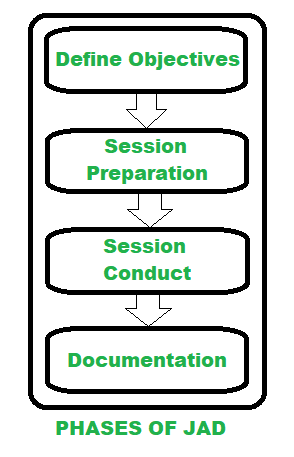Understanding Joint Application Development
Last Updated :
23 Nov, 2022
Joint Application Development in short JAD is the process which is used to design and develop computer based system/solutions. It collects requirements side by side as per business needs while developing new information systems for a company that means JAD involves the client or end-users in designing and development process. It also comprises of approaches for improving the quality of specification and user participation through a successive collaborative workshops called JAD sessions. Since client is involved throughout the development process it leads to faster development times and greater client satisfaction.
History of Joint Application Development :
Joint Application Development is developed by Chris Morris of and Tony Crawford during late 1970s with the aim to improve client satisfaction. In 1980s they conducted various workshops to prove the project and since then it has been applied in numerous industry sectors which has produced excellent products.
Participants in JAD :
There are many key stakeholders involved in JAD Process. These are:
- Execution Process : This process is from customer’s side which includes Project Manager, CIO, CEO or CISO who has the power to make decisions regarding the project.
- Facilitator : This individual is responsible for creating, managing and executing the JAD activities, minimize disagreements, encourage end-user involvement, maintaining focus and unbiased approach.
- IT Representatives : This individual for giving technical advice and to help the team to develop technical models and to build the prototype of end result. They must approach and support the customers in turning their visualizations into models as per the requirements, develop an understanding of the end-user business goals, represent in IT functions, render end solutions which are affordable in nature etc.
- End-User : This concerned person is usually the main focus of JAD. They offer proper business knowledge and strategy, illustrate all key user groups who are affected by development and represent multiple levels within organization.
- Scribe : This person is responsible for documenting JAD process and JAD sessions precisely and effectively. They generally serve as partner to facilitator in each JAD sessions and provide reference for the review.
- Observer : The observer will observe each JAD session and will gather knowledge for end-user needs and of JAD session decisions, interact with JAD participants outside JAD sessions only.
The below figure illustrates different phases of JAD

JAD Sessions :
- The JAD sessions must have well-defined objectives and agenda items. It is to be ensured that key persons are present from both technical and business world and from the one who take notes.
- For driving the meeting, questions and items are the essence of the discussion, and where we should not except fast answers. Also we should ask questions, record important items and assign action items.
- The aim of JAD sessions is to trigger creative thinking which leads to joint discussion that requires expertise from various departments.
- Teams should help each other in making decisions. If the teams can’t arrive to a decision then we need to run scheduled JAD sessions known as JAD workshops.
- We know that most of the JAD sessions are scheduled in developmental phase, it may happen during the requirement of the project.
Advantages of Joint Application Development :
These are some of the key benefits of JAD:
- Produce a design from the customer’s perspective.
- The teamwork between company and client helps to remove all risks.
- Due to the close interactions, progress is faster.
- JAD helps to accelerate design and also to enhance quality.
- JAD cheers the team to push each other which leads them to work faster and also to deliver on time.
Challenges faced in Joint Application Development :
- Sometimes opinions within the team members may differ which make difficult to align goals and maintain focus.
- On depending upon size of the project, in JAD people may have to spent significant amount of time.
Joint Application Development (JAD) may not be the answer what the organization needs, but it gives a much inclusive and flowing environment than others alike. JAD is used as a technique in early stages of a systems development of project for developing business system requirements. One of the purposes in JAD is to bring together MIS and end user in a structured workshop, which is accomplished by experienced JAD facilitators and customized, schedule agendas to assist the participant in completing high quality requirements. It is also seen that JAD process minimizes the development time, costs and errors.
Like Article
Suggest improvement
Share your thoughts in the comments
Please Login to comment...